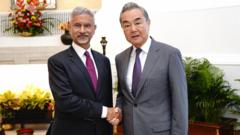In a landmark two-day visit to India, Chinese Foreign Minister Wang Yi expressed that China and India should prioritize partnership rather than view each other as adversaries. His remarks came during discussions with Indian Foreign Minister S Jaishankar, marking the second high-level interaction since the deadly Galwan Valley clashes in 2020, which severely strained bilateral relations.
Wang Yi's visit signifies a warming of ties, with both nations looking to transition from a challenging period towards collaboration. "We are happy to share that stability has now been restored at the borders," Wang asserted, after meeting with India's National Security Advisor, Ajit Doval, highlighting efforts to resolve boundary disputes. Significant discussions covered a variety of topics, including trade, pilgrimages, and data sharing about rivers.
Signs of rapprochement are evident as India and China aim to restore normalcy. This includes China facilitating Indian pilgrimages to Tibet and India revamping visa services for Chinese tourists. Furthermore, both nations are poised to resume direct flights, indicating deeper connectivity.
Wang's visit is particularly notable as it sets the stage for Indian Prime Minister Narendra Modi's upcoming trip to China, his first in seven years, to attend the Shanghai Cooperation Organisation (SCO) summit. While Modi may hold discussions with President Xi Jinping, official confirmation remains pending.
This diplomatic thaw occurs against the backdrop of India's increasingly strained ties with the United States, following recent tariffs imposed by the Trump administration on Indian imports. U.S. Trade Advisor Peter Navarro criticized India's engagement with both Russia and China, underscoring the complexities of India's foreign policy.
Jaishankar, echoing Wang's sentiments, underscored the mutual goal of fostering a balanced, multipolar world order, while emphasizing the necessity for enhanced stability in the global economy. The evolving narrative between China and India promises to reshape geopolitical dynamics in the region.
Wang Yi's visit signifies a warming of ties, with both nations looking to transition from a challenging period towards collaboration. "We are happy to share that stability has now been restored at the borders," Wang asserted, after meeting with India's National Security Advisor, Ajit Doval, highlighting efforts to resolve boundary disputes. Significant discussions covered a variety of topics, including trade, pilgrimages, and data sharing about rivers.
Signs of rapprochement are evident as India and China aim to restore normalcy. This includes China facilitating Indian pilgrimages to Tibet and India revamping visa services for Chinese tourists. Furthermore, both nations are poised to resume direct flights, indicating deeper connectivity.
Wang's visit is particularly notable as it sets the stage for Indian Prime Minister Narendra Modi's upcoming trip to China, his first in seven years, to attend the Shanghai Cooperation Organisation (SCO) summit. While Modi may hold discussions with President Xi Jinping, official confirmation remains pending.
This diplomatic thaw occurs against the backdrop of India's increasingly strained ties with the United States, following recent tariffs imposed by the Trump administration on Indian imports. U.S. Trade Advisor Peter Navarro criticized India's engagement with both Russia and China, underscoring the complexities of India's foreign policy.
Jaishankar, echoing Wang's sentiments, underscored the mutual goal of fostering a balanced, multipolar world order, while emphasizing the necessity for enhanced stability in the global economy. The evolving narrative between China and India promises to reshape geopolitical dynamics in the region.




















